Raphael Hamm has been working in visual effects for almost 20 years. He has worked in many studios such as Scanline VFX and Trixter before joining DNEG in 2009. He has worked on a various films including Iron Man 2, Man of Steel, Interstellar and Dunkirk.
What is your background?
I am a compositor by nature – working in the vast field of 2D for nearly 20 years – 11 of them at DNEG. I started my career with them as a mid-level compositor on Harry Potter and the Deathly Hallows Part 1 and stepped up as lead and compositing supervisor for the likes of Terminator Genisys, Interstellar and Dunkirk. Shadow and Bone was my third show as a VFX Supervisor and of course I had a strong focus on the 2D side of things.
How did you and DNEG get involved on this series?
Ted Rae, client VFX Supervisor of the show, liked the work we did on other shows and had the feeling that we would be a good partner for him as a main vendor. He had his own team for the shoot and previs and contacted us while he was shooting in Hungary for some first visualizations and concepts for some of the key effects of the show. They managed to finish shooting just two weeks before Europe went into lockdown. On his way back to LA, Ted stopped over in London for a productive week that allowed us to touch base on every key effect of this series. The plan was for him to come back at a later point, but… 2020 developed into another direction.
How was the collaboration with the showrunners, the director and VFX Supervisor Ted Rae?
Our main points of contact were Ted and Tolly Swallow (VFX producer). They managed the communication with the creatives – and did a great job. Ted knew exactly what Eric Heisserer (showrunner) was looking for and could direct us to the results they wanted without any detour – which was a huge accomplishment. With Ted we established a workflow that allowed us to present layouts and rough versions to Eric, to get early feedback instead of burning days.
What was their approach and expectations about the visual effects?
A key focus was the establishment of aesthetic ground rules and compositing parameters to marry VFX work into the subtle distortions, aberrations, and depth-of-field characteristics of the anamorphic principal photography, blending those ‘magical’ VFX elements believably into ‘Shadow and Bone’ Season One’s unique visual style. Or… creating photoreal magical effects.
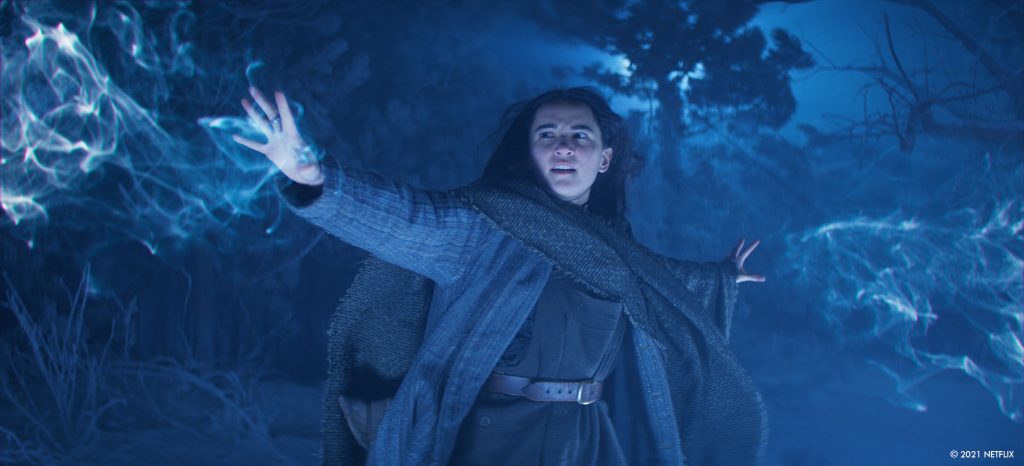
How did you organize the work with your VFX Producer?
It was the second time that I had the honor to work with Natalie Reid – we are a great team by now. We trusting each other completely and know the strengths and weaknesses of the other quite well and can support each other accordingly. As it was our first remote-working show we had to invent new ways to communicate – now that the casual office talk was no longer possible.
She is a shotgun wizard, but I have to admit that never-the-less we had a few Google-spreadsheets to make my life easier – especially for bidding or interactive target meetings. We also established an end of day call with the core team to discuss the next steps and organize the next day. These calls were very important as they were not pure business talk and helped to up the moral in these difficult times.
How was split the work amongst the DNEG offices?
The London office was the creative hub that did the majority of the lookdev and setup work, eg. setting up the light effects and building the white stag. Montreal, led by Jay Randal (VFX Supervisor) and Oliver Eikhoff (Producer), did the heavy lifting for episodes 7 & 8 – using and adapting the setups Mario Brioschi (2D Supervisor) and William Carley (CG Supervisor) had provided. They also owned and developed Kirigan’s shadow power. London and Montreal developed the look and layout for our key- and hero-shots, and our Chennai studio in India was a partner for both sides to help with the in-betweens and RPM.
What are the sequences made by DNEG?
Our contributions included hundreds of environment extensions, the development of organically supernatural light effects, and the realization of a photo-real, yet magically over-sized, white stag. The challenge for Alina’s light was to develop a look that developed accordingly to Alina’s level of control – from a single light beam in episode 2, over multiple stages of instable and stable light spheres while she is learning to control her powers, to a massive light dome and tunnel in ep8 when she has full control.
Another huge task was Kirigan’s shadow magic, including the “cut” effect, where the shadow is materializing into a deadly blade – which was driven by Jay in Montreal. We were also looking after a nice mixed bag of smaller tasks, like the ship-ocean establishing shots in episodes 3 and 4, the little palace modifications, the establishing shots for Novokribirsk in the first and third episode or some wind-magic (dust devil) for the squaller appearance in episode 1.
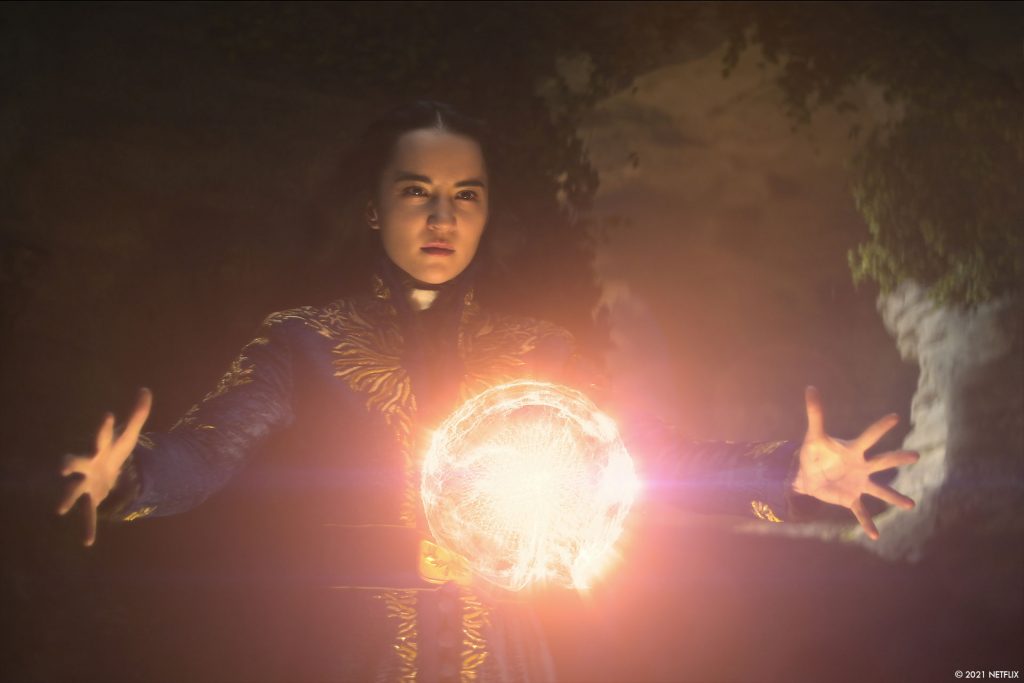
The series is full of magic and powers. Can you elaborate about this aspect?
Creating the Grisha magic for the world of ‘Shadow and Bone’ has been a unique experience – both on the creative and technical side. On the one hand side they should follow the laws of nature and on the other and they should be magic – photoreal magic. For us, it meant that each of those powers, from controlling a shadow, to the summoning of a sun had to be as real as possible and based on nature. For Alina’s light for example we tried to add and recreate as many real optical elements that would indicate to us that the light was in the plate – adjusting the interactive light in the plate, adding flares, playing with exposure and saturation values and adding a few lens tricks like iris pull or matching chromatic aberration levels.
Another challenge for Alina’s light was that it had to develop over the course of the 8 episodes – from a weak and uncontrolled event to a strong and powerful statement. Our aim was that each stage is connected with each other and not appears randomly. We wanted that the light-effect is following its own “grammar”.
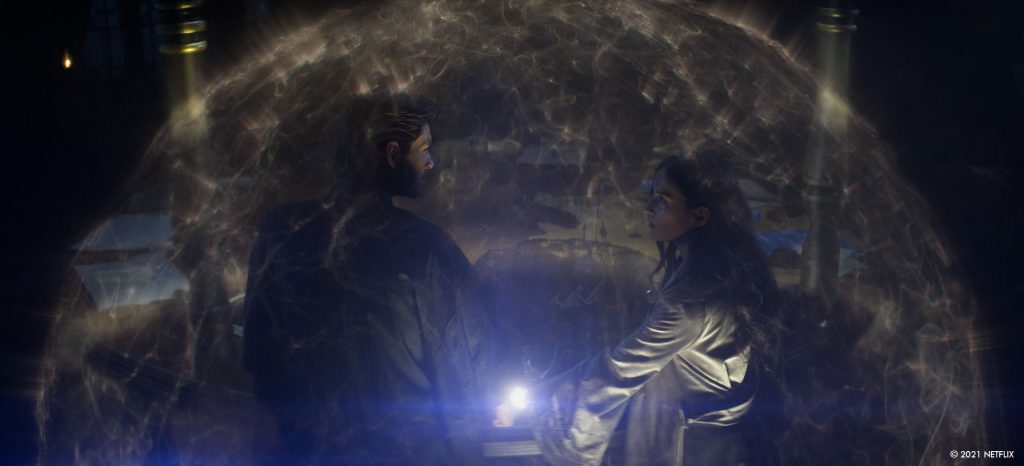
How did you create the various magical FX?
Alina’s light was close cooperation between the FX and Compositing department – with comp being the driving force. DNEG compositing supervisor, Mario Brioschi, developed a 3D space setup in Nuke using generic FX passes developed by FX lead George Kyparissous in Houdini combined with a sophisticated Nuke particle system to have full control over the timing and the look in comp. We wanted a solution that enabled us to adjust the effect with a short turnaround in compositing and to be able to react faster to client feedback. This setup was easy scalable – it worked in the same way for a small light sphere as for a massive light dome.
It’s very dark inside the Fold. How does that affect your work especially the lighting?
The challenge for the last episode was to find the right balance between our light bubble and the on-set-lighting. We wanted to keep it dark, but the plate had a “strong” top light. Our solution was to have a brighter celling texture (nickname “fishbone”) that we would see in wide shots and would remind us about the light conditions, while at the same time allowing us to have a darker lower half of the bubble. Another challenge here was how to introduce the sense of a forward movement of the skiff whilst the bubble is position locked to the skiff. Our solution was to give the bubble a slight spinning motion (nickname “gerbil ball”) to give the texture a hint of a directional movement without breaking the sphere idea.
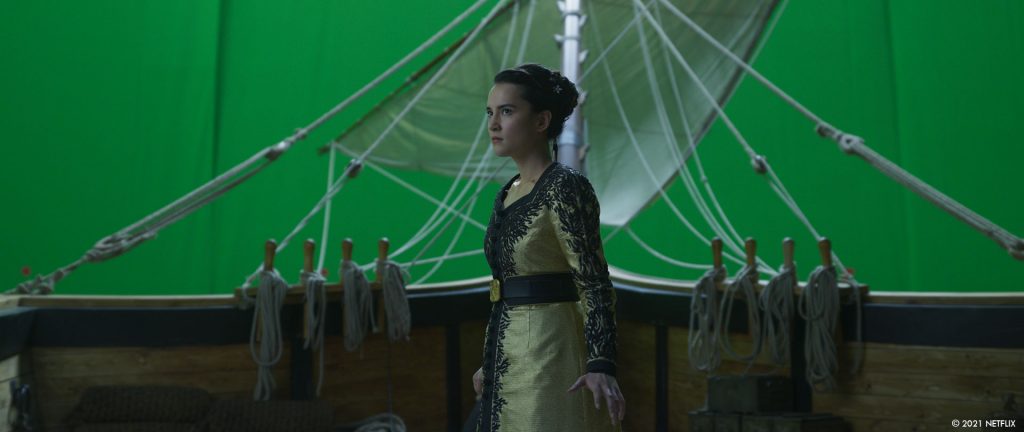
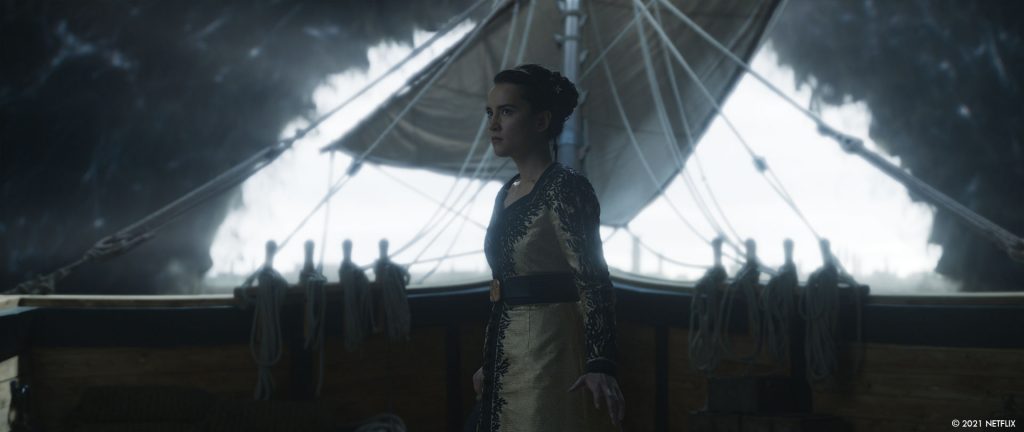
Can you explain in detail about the creation of the beautiful stag?
For the creation of the stag we firstly developed the model by playing with form and design to ensure that the proportions felt correct, the challenge was to take a traditional male stag and make him much larger in mass and form to emphasise his strength and scale. The key was to ensure he looked powerful by introducing weight and volume especially in the neck and chest area. Ted referenced Arnold Schwarzenegger – he wanted to have the stag strong and powerful, but in an aged version – like Arnie.
Once happy with the model we then rigged the stag to ensure that he was able to have a large range of motion as we knew that later in the series there would be scenes that really tested the rig with some quite complex animation that needed to feel as authentic as possible. Whilst rigging we were then able to begin the process of creating the fur using Maya, Houdini and some in house tools developed at DNEG to ensure the groom matched the clients brief.
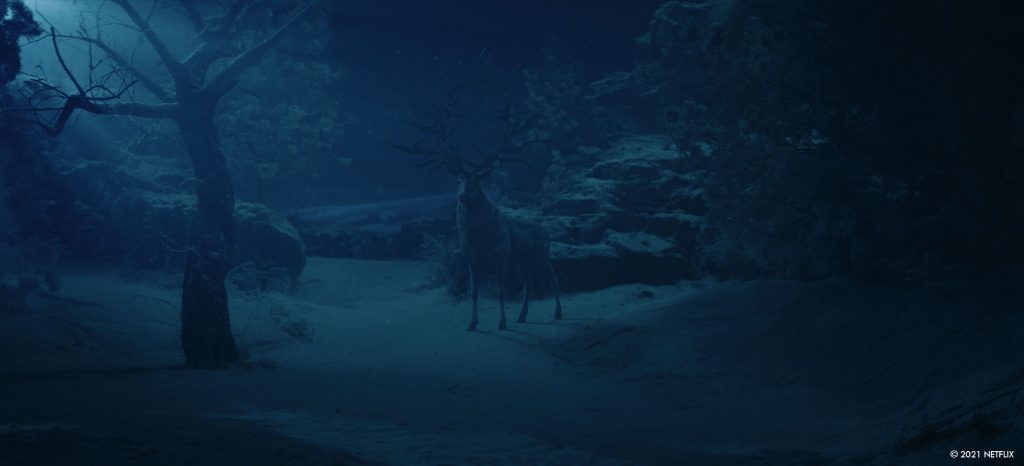
Can you tell us more about the challenges of his white fur?
We looked at a lot of reference for different types of stag fur especially using albino stags as a strong reference point. We quickly realised that having the stag fur entirely white made him look too clean and also more youthful than we intended. Given that he’s a mystical creature that’s potentially centuries old that has always lived in the wilderness, we began re-introducing elements of grey back into the fur that really helped show a more mature age and also helped make him look more weathered and dirty, giving him much more character. One of the biggest challenges was also simming the fur. To overcome this, we chose an approach of pinpointing areas that we would like to see more movement in, this allowed us to hero areas that were full frame whether it be a subtle breeze or a sway as he walked through the undergrowth.
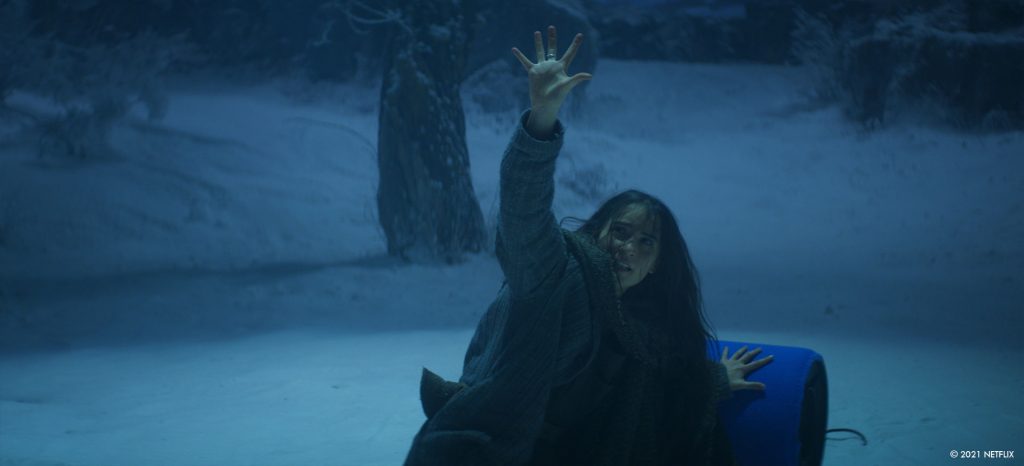
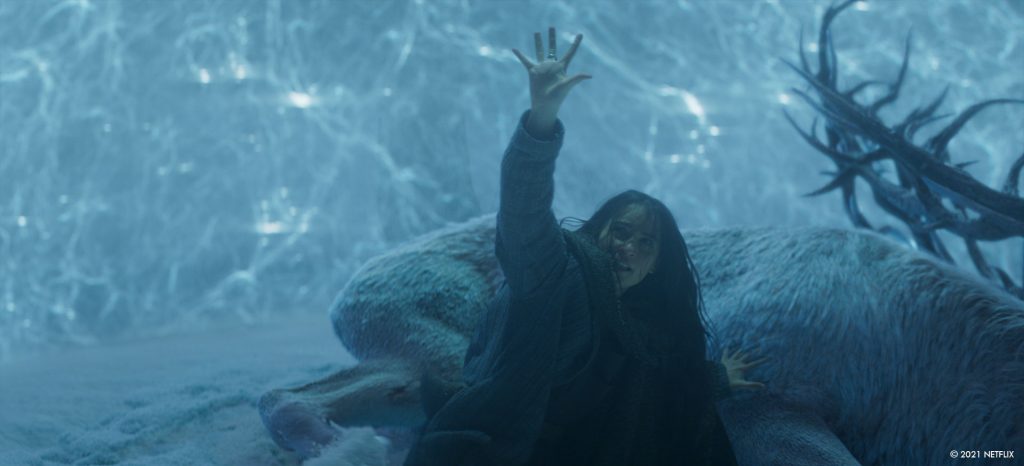
How did you create his majestic horns?
The antlers were created in Maya, ZBrush, Substance designer and Mari. We knew these were a big character point due to their huge scale so would require a lot of fine detail. One of the design briefs was to have the antlers almost feel like a branch to trick the viewer until you pull back to reveal the stag, so it was really import that they held up close to camera. In a few scenes where the antlers needed to be covered in icicles, we used Houdini to create the forms of ice hanging from different positions scattered across areas where moisture would potentially run down and form icicles.
What kind of references and influences did you receive for the animations of the creatures?
The challenge for our stag animation team was to create the impression of a real-life stag whilst being a majestic creature with its own character. It might not surprise that we had a wide range of reference clips we had to use for our animation. We had multiple clips of walking stags, how they are holding their heads and twitching their ears and of course a few clips of stags that got shot. Another set of reference were from horses, as the real life walk cycle of a stag is not that elegant. Their walk looks fine on an uneven and shrubby terrain but on a flat surface like our snow clearing their back legs look very wooden and mechanical. And for the heroic touch, we were referencing Bambi’s dad.
The series is taking us to various environments. Can you tell us more about your work on them?
I like shots with a great before/after feel – all the encampment work we did has this for me. I still find it fascinating to see how an image comes to life once you are removing the green screen – and Robin Konieczny, London Head of Environments, and his team did a great job. For the encampment sequences – we had photogrammetry of the actual backlot set that we used as a starting point – to build CG versions of the tents and used props. Based on the cut we decided which shots would benefit from our CG setup and for which shots we could just use a card setup in Nuke. As the trees were all in the far distant, we decided to keep them as cards all the time.
My aim was to present Ted Rae a rough temp version for all encampment shots within a few weeks after turnover to help editorial with the flow of the sequences. We had a similar approach for Novokribirsk – here we started with concept art. Once we had an agreement on the layout, we tracked the concept image into the plate to give them a better idea of what this sequence will look like – and from here on we had the time to work up the shots in our pace.
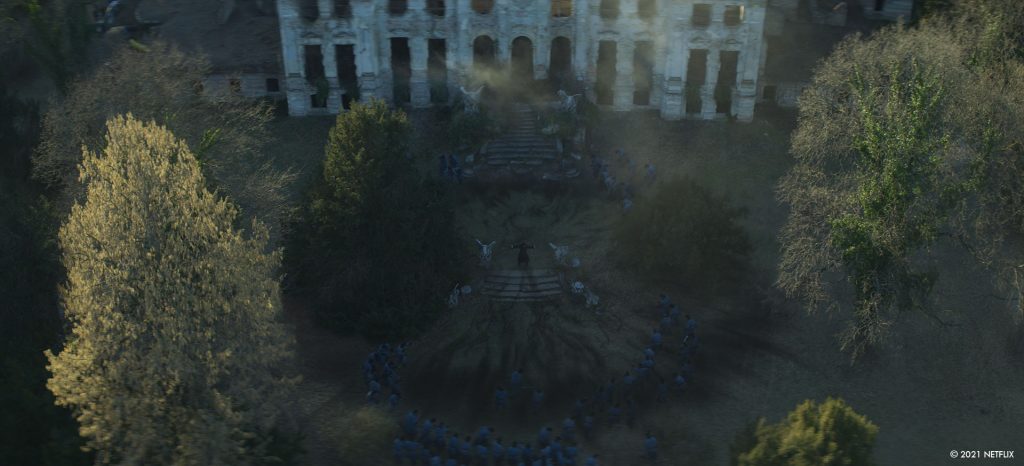
Which sequence or shot was the most challenging?
We had a few shots that we shared with El Ranchito studio, based in Madrid. I would say that theses shots were quite complicated as they had another level of communication going on. How to split? How to exchange data? Schedule… We did the light magic for the first crossing and El Ranchito the Volcras. There were many versions going back between London and Madrid. David Lee, I hope we haven’t caused you too much pain!
Is there something specific that gives you some really short nights?
I have to say that Shadow and Bone was one of the smoothest shows I have ever worked on. Of course, there were a handful of shots at the very end of the project that Ted, Jay Randall and I wanted to push to the maximum – until the time runs out – but this was nothing unusual. We always knew that we would deliver these shots. For me the project was overshadowed by the uncertainty of the pandemic. We all had to learn a new way of working! There were days that were very challenging, and I didn’t know how we should manage the work or how I should keep my team motivated and focused while there were huge economical and financial threats all around us.
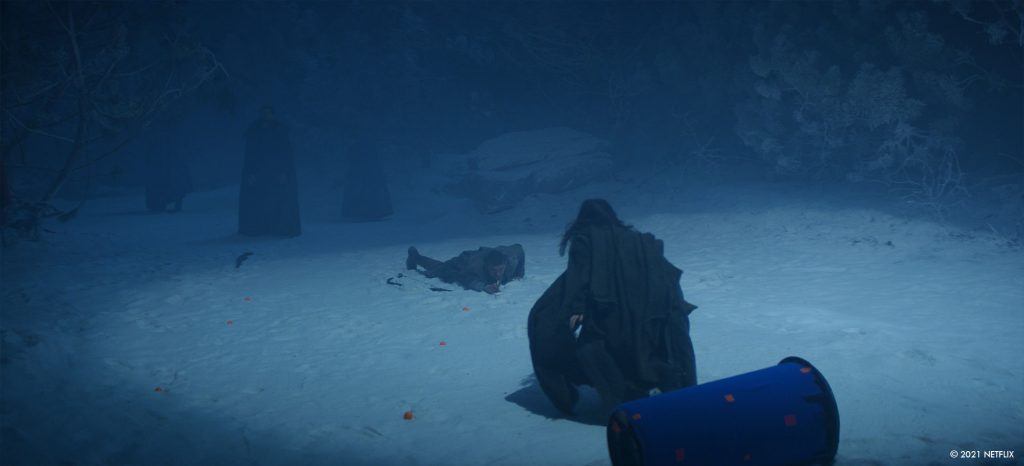
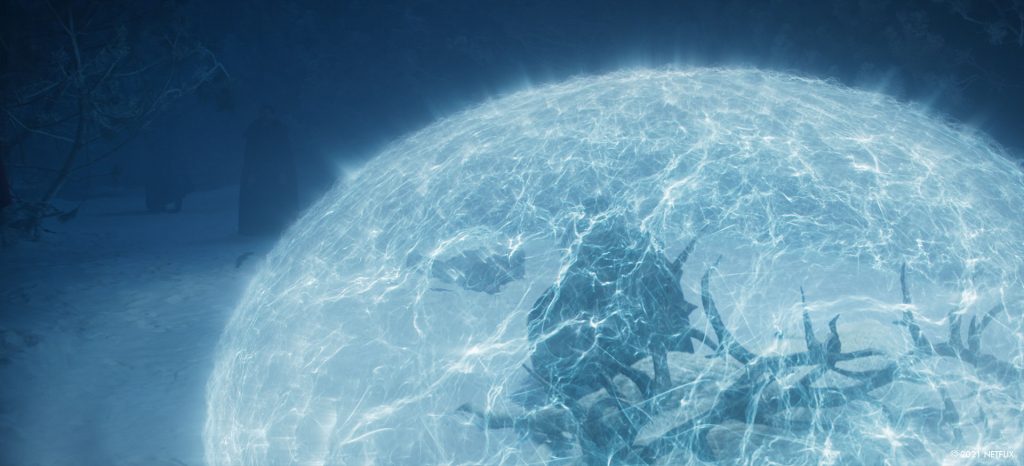
What is your favorite shot or sequence?
There are so many good ones. I really like the end of episode 4 when our stag (his nickname was Herman) is revealing himself to Mal. This beat was not playing nicely for a while and Ted asked me to help him to rearrange the cut and the design of the shots. I am always up for a challenge and like to get more involved into the actual storytelling. I am quite proud of the result and input I had here.
Ah – and while writing… the opening of episode 3 is beautiful. The closeup on the antlers followed by a gorgeous wide shot of the stag.
What is your best memory on this show?
Hard to tell… we had some great ‘Frankie’ sessions with Ted. Having a client who is appreciating your work gives you a good feeling. But I think the best memory is that we managed to do a brief Christmas Party with the inner circle of the project in person – just a few days before we went into another four-month-long lockdown. It was really great to see each other again – for the first time since switched to WFH in March.
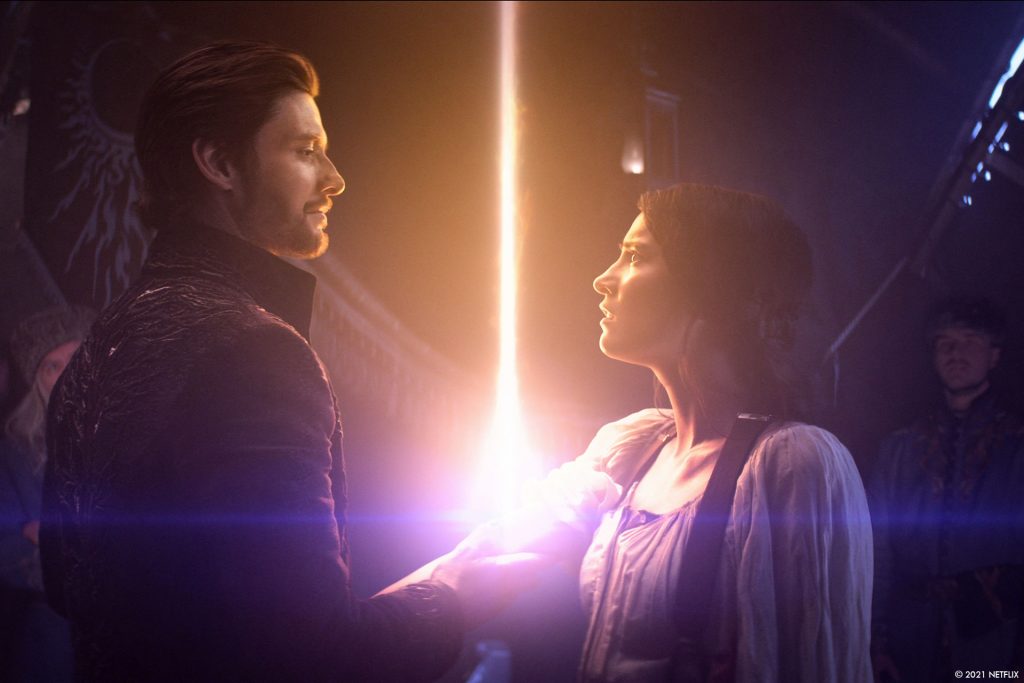
How long have you worked on this show?
Due to the pandemic we had to change the original schedule of five to six months. In the end I was involved around 14 months (my longest show ever!)
What’s the VFX shots count?
574.
What was the size of your team?
The global head count was 177 artists, plus RPM.
What is your next project?
I am currently enjoying a few weeks of downtime!
What are the four movies that gave you the passion for cinema?
I think the The NeverEnding Story (1984) was the first time that I discovered movie-magic and was blown away by this created world. It was the first time that I saw a before-after documentation and decided that I want to do “something like that” when I am a grown up. There were other movies that reminded me about that thought – like Terminator 2 (1991) or The Matrix (1999).
A big thanks for your time.
// Shadow and Bone – VFX Breakdown – DNEG
WANT TO KNOW MORE?
DNEG: Dedicated page about Shadow and Bone on DNEG website.
Netflix: You can watch now Shadow and Bone on Netflix.
© Vincent Frei – The Art of VFX – 2021




